We have a strict honesty policy, but please note that when you buy through our links, we may earn a commission. Learn more.
Welcome to our Shopify vs eBay comparison. In this post I’m going to highlight the key differences between the two platforms and help you work out which one is right for your ecommerce project.
Let’s start with a look at the fundamental difference between the two platforms.
The key difference between Shopify and eBay
Shopify and eBay are two of the best-known names in the world of ecommerce. But although you can use both services to put your goods in front of a huge audience, they are two very different platforms.
Shopify is a tool that lets you create your own online store. Today, it powers over 4.9 million online stores (source: Builtwith.com).
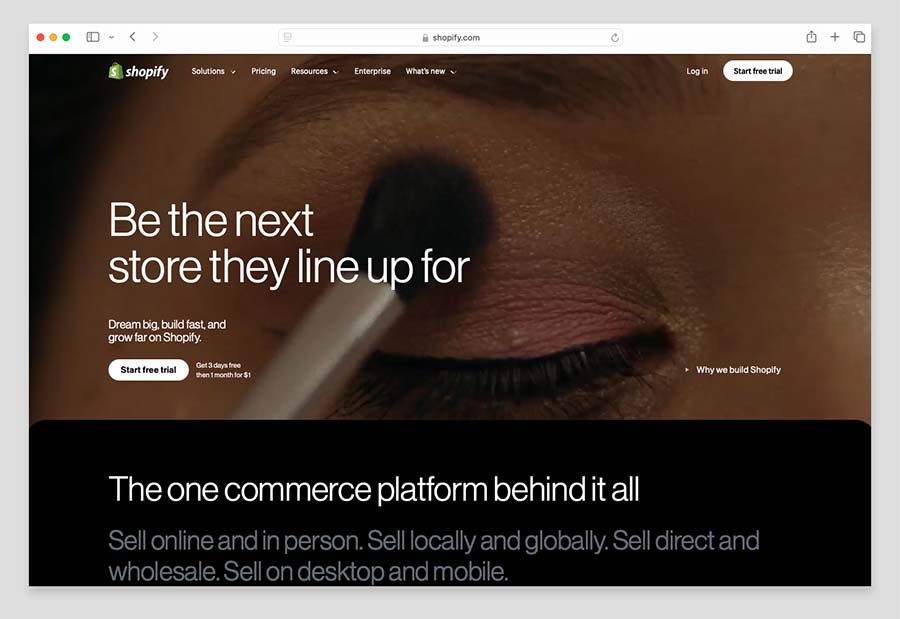
By contrast, eBay IS an online store — and a huge one at that. With 19 million merchants, 2.3 billion live product listings, 134 million active buyers and 2 billion transactions taking place every day, it’s the second-biggest online marketplace in the US after Amazon.
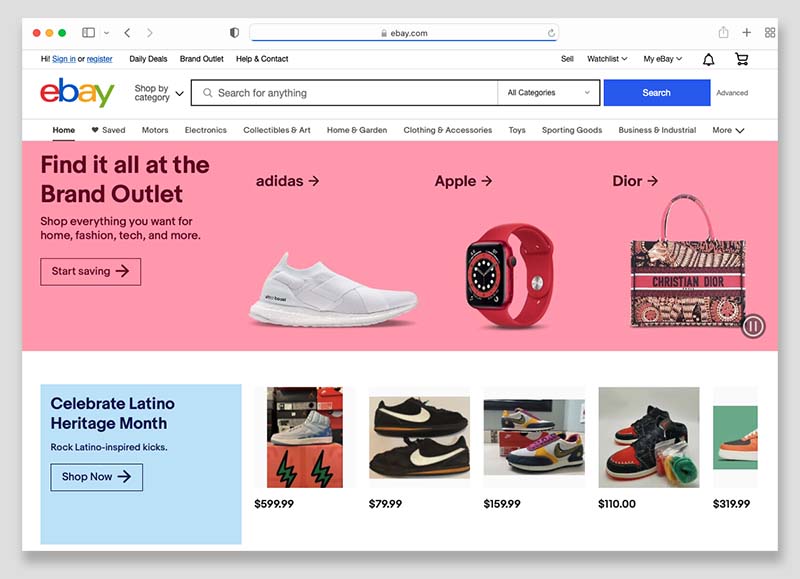
The first key difference between Shopify and eBay involves how you find your customers.
When you sell on Shopify, it’s the online version of renting a premises in which to set up your own shop. And, much like running a real-world shop, it’s up to you to get the customers to walk through the door and buy your products.
By contrast, selling on eBay is more like having your goods on sale in a gigantic supermarket (and in the case of eBay, we’re talking about a ‘supermarket’ that has over 132 million customers already in the door!).
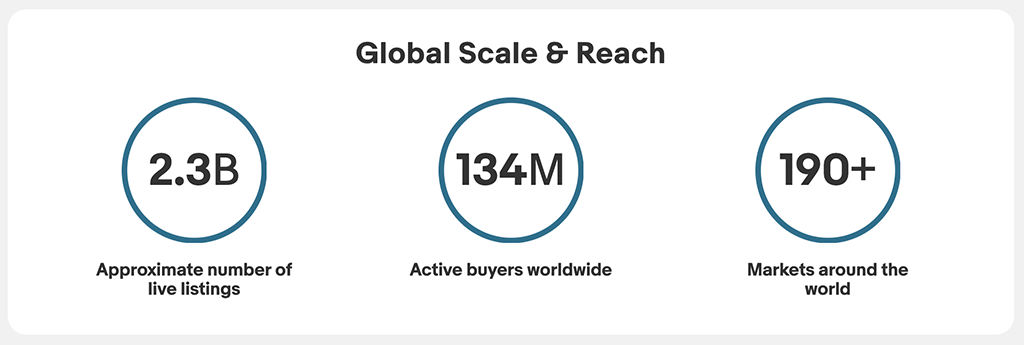
Another key difference between Shopify and eBay is the control you get over your brand and online sales process.
With Shopify, you’ll have more work to do to set your store up the way you want, but the upside of this is that you get total control over most aspects of your store. It lets you decide:
- what your store looks like
- how your brand is presented
- the domain name for your store
- how you capture data
- the way you sell your goods
With eBay, by contrast, you are much more limited in how you can present your goods to your customers. While eBay does allow you to create your own store, the options for creating unique branded experiences in eBay — as we’ll see later in this comparison — are few and far between.
For the most part, eBay shoppers will encounter your goods as product listings — alongside similar goods on sale from your competitors — in search results. And when it comes to purchasing an item, buying something on eBay will involve an identical set of steps for the customer, regardless of which eBay merchant is selling the item.
Depending on the plan involved, Shopify can offer more flexibility over this checkout process.
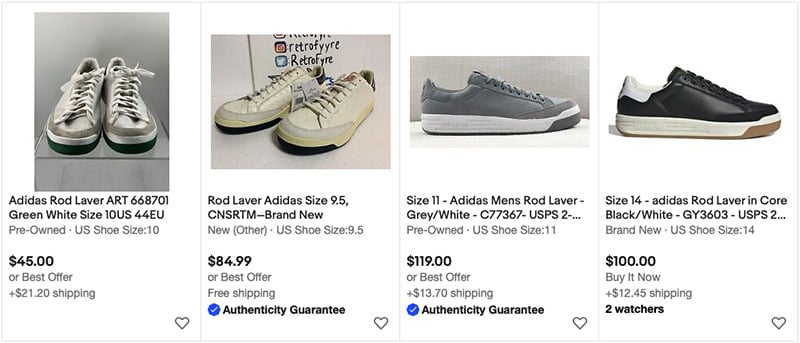
There are pros and cons to both these ways of selling — I’ll discuss these in more detail later on in this comparison.
But first: how easy are the two platforms to use?
Ease-of use
Shopify and eBay are both designed to be easy for ecommerce beginners to start selling with. When you sign up for an account on either platform, a guided onboarding process leads you through all the necessary steps to start making sales.
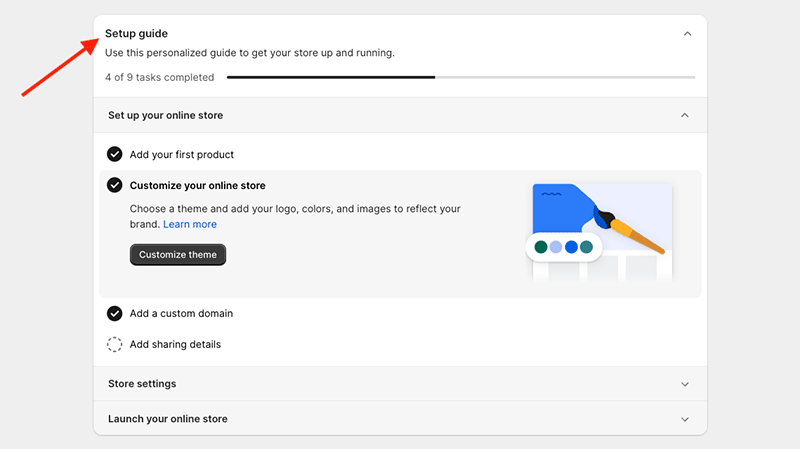
Additionally, both platforms provide a comprehensive set of online resources and training videos to help new sellers get to grips with things.
Now, while it’s relatively straightforward to create an eBay personal account to start selling with, setting up a business account requires quite a lot of form-filling and paperwork.
Business sellers on eBay need to provide:
- a business name, type and address
- a phone number
- proof of identity
- commercial bank details
- details of beneficial owners, directors and account managers.
There’s much less red tape with account setup in Shopify. All you need in the initial stages is an email address and basic contact details — you just enter these when starting a free trial.
As for getting your products online, the two platforms take different approaches here too.
To sell on eBay, you need to create product listings that appear when customers search for the sort of items you’re selling.
So the key challenge new eBay merchants face is meeting all the requirements regarding product names, auction details and product conditions, and making sure that all the relevant data entry (of which there’s quite a lot!) is performed correctly.
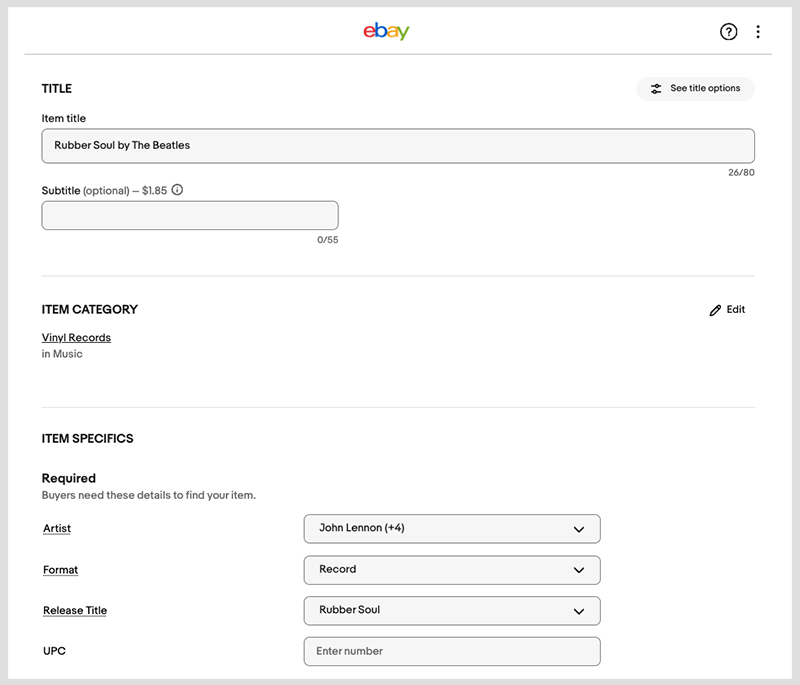
With Shopify, you aren’t just dealing with product details — you are essentially building a whole website. And this means that in addition to creating products on your store, you’ll need to perform several web design tasks, including:
- customizing store templates
- creating web pages
- mapping domains
- optimizing pages for search engines.
Although — with perhaps the exception of the fourth task — the learning curve for these tasks is fairly gentle, if you’re a total web design novice, there can be quite a lot to get used to.
Tip: check out our ‘How to start a Shopify store’ tutorial for help with all this).
Now, let’s take a look at branding and user experience.
Control over branding and user experience
As is the case with most online marketplaces, when you sell with eBay, limits apply to how you can present your brand.
With an eBay store account, you can pick a store name, upload a logo, display a store video and add a banner image. But you won’t be able to customize things like typefaces, color schemes or page layout.
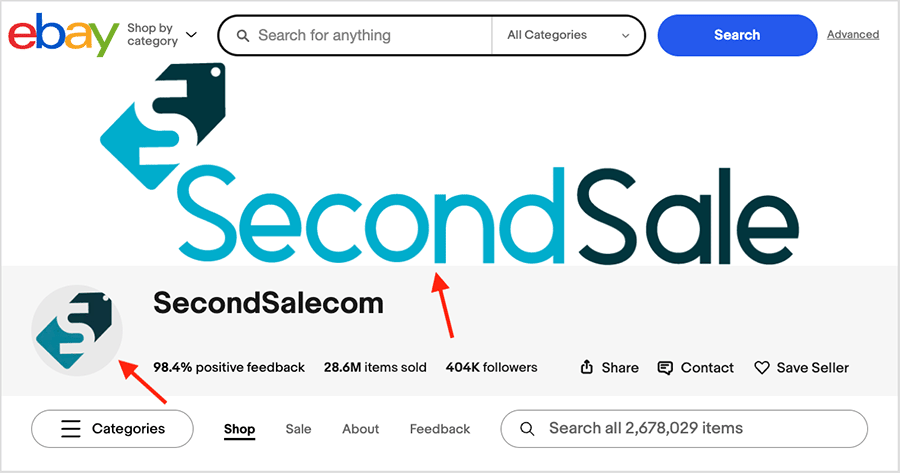
This lack of store customization features isn’t necessarily a bad thing, because eBay shoppers expect a certain type of shopping experience — and straying too far from the standard eBay format could lead to a negative impact on sales.
Shopify, by contrast, gives you a huge amount of control over your brand and the overall store experience. A wide range of storefront themes is available — I counted 246 in total at time of writing — and these can be extensively modified to match your brand’s style.
And, if you are technically-minded, you can edit your Shopify store’s code to change its layout and improve user experience (UX).

And finally, powerful multi-currency and multilingual features in Shopify let you customize your store for users in lots of different countries — so ultimately, if you want to create a bespoke shopping experience targeting a particular buyer, persona, market or location, Shopify is a better choice than eBay.
Shipping and dropshipping
A particularly important feature to focus on when comparing eBay vs Shopify is shipping.
Shipping products with eBay
eBay merchants can choose from a wide range of shipping options for getting their goods to their customers, including:
- Fixed cost shipping
- Flat rate shipping
- Free shipping (for purchases over $25)
- eBay calculated shipping (based on weight and dimensions of package and the buyer’s location)
- Freight (for large items)
- Local pickup
For domestic shipping in the US, EBay works with USPS, FedEx, UPS, DHL eCommerce, Amazon Logistics, OnTrac, Lasership, Spee-Dee Delivery and Lonestar Overnight and Amazon Logistics.
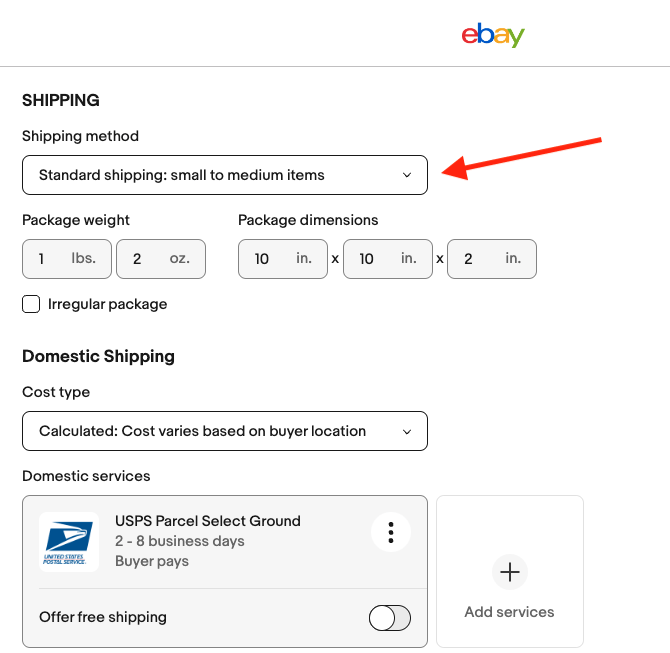
A handy shipping calculator is integrated into eBay’s product listing tool, making it easy for merchants to set shipping types.
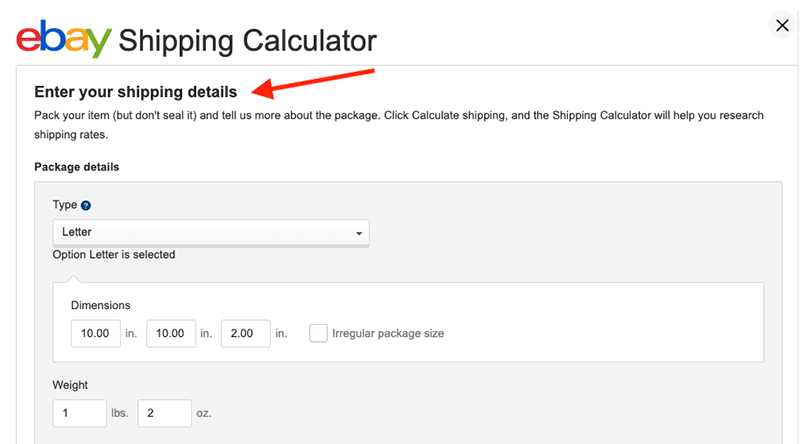
Additionally, eBay lets you print shipping labels that provide 30% discounts on USPS retail prices and 37% discounts on FedEx shipping rates.
For international shipping, US-based merchants can use eBay’s Global Shipping Program. This provides a range of additional benefits, including guaranteed five star shipping reviews in your seller profile and extra seller protection in cases of lost or broken items.
There is also a selection of specialist import, export and freight shipping services available to eBay sellers.
Shopify shipping options
With Shopify, you can set your own shipping rates based on product weight, quantity and — unlike eBay — product price.
Shopify also offers merchants in some countries access to its ‘Shopify Shipping’ service — a real-time carrier quotation system that provides significant shipping discounts for users in the US, Canada, Australia, UK, France, Germany, Italy and Spain.
You can reduce your postage costs by as much as 88% by enabling this feature.
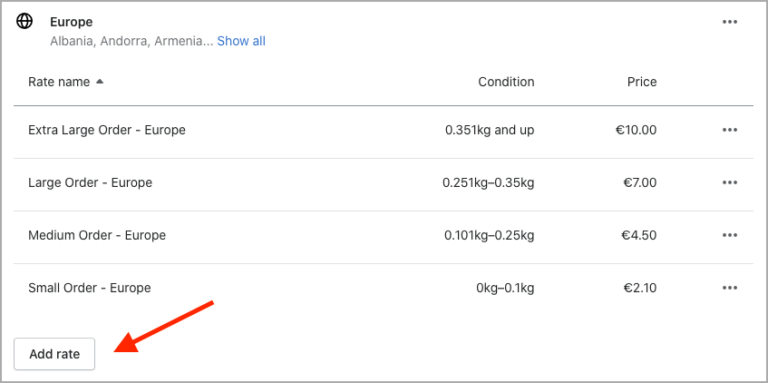
Shopify store owners in the US and Canada who get at least one order per day can also make use of the ‘Shopify Fulfillment Network‘. This gets your goods to your customers within 2 days, and also provides product returns and inventory restocking services.
If you don’t want to ship your products yourself, or use the Shopify Fulfilment Network to do so, you can use your own shipping software via a third party app (many are available from Shopify’s app store).
Alternatively, you can consider dropshipping. Let’s take a quick look at that.
Dropshipping with eBay and Shopify
Dropshipping is a way of selling goods where you don’t make, stock, or deliver any products. Instead, you take an order via your online store, send it to a supplier, and they package up the item and ship it to your customer.
Both Shopify and eBay both let you operate a dropshipping business, but do so in different ways.
With Shopify, you start dropshipping by connecting your store to a dropshipping app (my search of Shopify’s app store revealed that there are currently 647 to choose from).
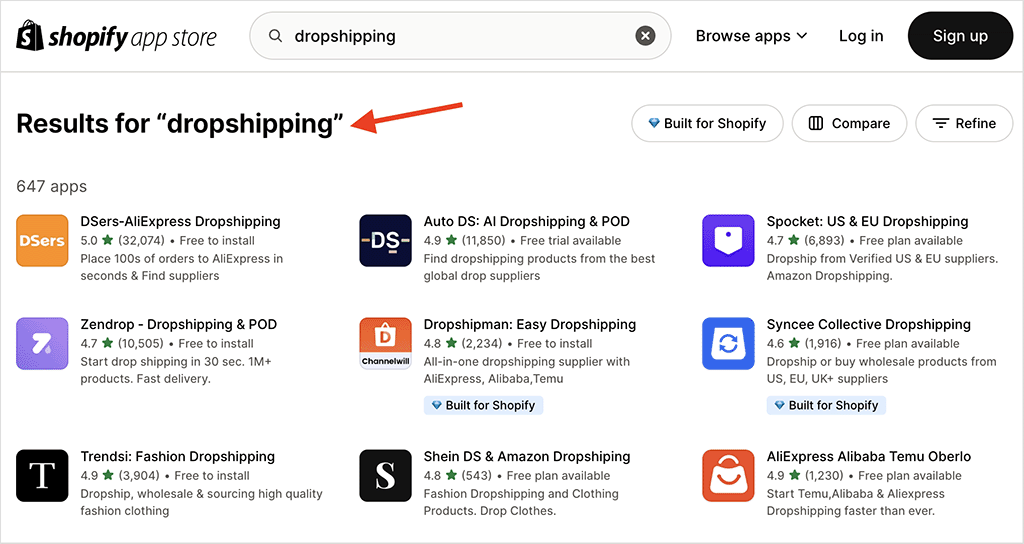
Dropshipping apps for Shopify let you browse a large product inventory and add the items you’d like to sell to your store — it’s a fairly streamlined, automated process and the fees involved are relatively low.
You can dropship on eBay too, but it usually involves a more manual process than Shopify — unlike Shopify, there’s no app store to help you locate dropshipping suppliers, and the processes involved vary considerably depending on the suppliers involved.
That said, lots of dropshipping companies — including major ones like Spocket, Doba and DSers — do facilitate dropshipping on eBay and provide tools and support to help you with it.
There’s a couple of key things to be aware of however when dropshipping on eBay.
- eBay only lets you source products from wholesale suppliers — i.e., not retailers like Amazon or Walmart. Shopify doesn’t apply these types of restrictions.
- Depending on how many products you intend to dropship on eBay, insertion fees — of between $0.05 and $0.35 — may apply. So, if you’re dealing with a very large dropshipping inventory, this is something to watch out for — there may be significant upfront costs to consider.
(More on pricing shortly!).
So overall, when it comes to dropshipping, it’s ultimately a lot easier to do on Shopify.
Print on demand with Shopify and eBay
A number of print on demand suppliers — including big hitters like Printify and Printify — provide integrations for both Shopify and eBay. These let you design products featuring a design that you upload — products that are only created and shipped after somebody buys one on your store.
The process for linking a Shopify store to a POD supplier is slightly easier however — connecting eBay to a POD platform means involving PayPal in proceedings, which makes things fiddlier.
Now, let’s move on to something very important: how you actually get customers to your online store.
Attracting customers to your store
Accessing customer bases
When it comes to getting products in front of a ready-made customer-base, eBay is the hands-down winner in a Shopify vs eBay contest.
Why?
Well, thanks to its 134+ million customers in over 190 countries and its 600+ million average monthly visits, having a storefront on eBay puts you in front of a huge audience that spends a lot of money.
That’s not to say you will be inundated with orders the moment you start selling on eBay — it’s a very competitive marketplace. However, your products will be immediately available on a hugely popular platform. And, so long as you have identified a good niche to sell in, created compelling product descriptions and established a competitive pricing strategy, you do stand a good chance of generating sales.
Helpfully, eBay provides a free and very useful tool to assist you with all this: ‘Terapeak‘. This lets you identify popular products, perform competitor research and optimize listings and product descriptions.
You can also make use of paid-for ‘promoted listings’ in eBay to further boost your products’ visibility on the platform.

And eBay’s algorithms can help merchants out too, by displaying recently-viewed or ‘recommended for you’ items to shoppers. Once your products start getting clicked on or purchased, your listings can benefit from the increased visibility delivered by these algorithms.

And finally, if you’re selling products at competitive prices, features like eBay’s ‘great price’ labels (pictured below) and its pricing filters (which allow users to sort product listings by price) can further raise the profile of your products.
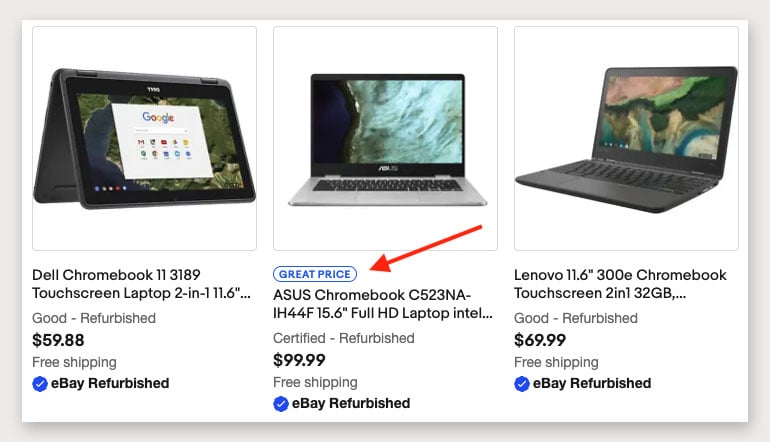
Now, when you build a new Shopify store, you won’t really have an existing audience to sell to, or algorithms automatically marketing your products to people who are likely to buy them. So it will be up to you to get traffic to your online store and build your own audience.
Because of this, you’ll need to dedicate a lot of time and effort to SEO, content marketing, online advertising and online PR to attract customers to your store. All these can be an expensive and time-consuming tasks that involve significant learning curves. However, if you succeed in your efforts, you’ll have an online business that you control.
This is because running a business on eBay means doing everything on eBay’s terms, and there is always the risk of a significant change being made to the platform’s operations, algorithms or terms of business that can negatively affect your business.
Now, running a Shopify store is not without risks either: the potential impact of Google core updates on your store’s traffic, for example, can be huge. But in general, you are more ‘in charge’ of proceedings, and there is much to be said for the independence, control and stability that running your own online store gives you.
And this control doesn’t just extend to the day-to-day running of your store: it actually affects your ability to exit your business. While you can sell your Shopify store if you wish, eBay prohibits you from doing so.
So there’s a trade off: eBay gives you access to an existing audience, while Shopify gives you control over how you build one.
And one of the key ways of doing this is via…
Content marketing
Content marketing is a popular traffic generation strategy in the world of ecommerce — it involves creating interesting blog posts, videos and other forms of online content to attract visitors to your store.
With Shopify, you can use its built-in blogging tool to create posts about topics related to your ecommerce niche. Now, based on my experience of blogging with it, it has to be said that the Shopify blog is a bit on the basic side — the interface is clunky, you can’t create author pages with it and there’s no drag and drop editing available. It’s no WordPress! But ultimately, it does the job, and content you produce with it can rank highly in search results.
(And to be fair, if you want a more sophisticated blog for your Shopify store, there’s always the option of using a third-party app to create one — several are available in Shopify’s app store).
If you want to perform content marketing for an eBay store, you’ll need to set up a separate blog (using a platform like WordPress or Squarespace) and insert links to your eBay’s store’s products in your articles. This adds costs and configuration time to proceedings.
So, when it comes to getting going with content marketing easily, it’s a win for Shopify.
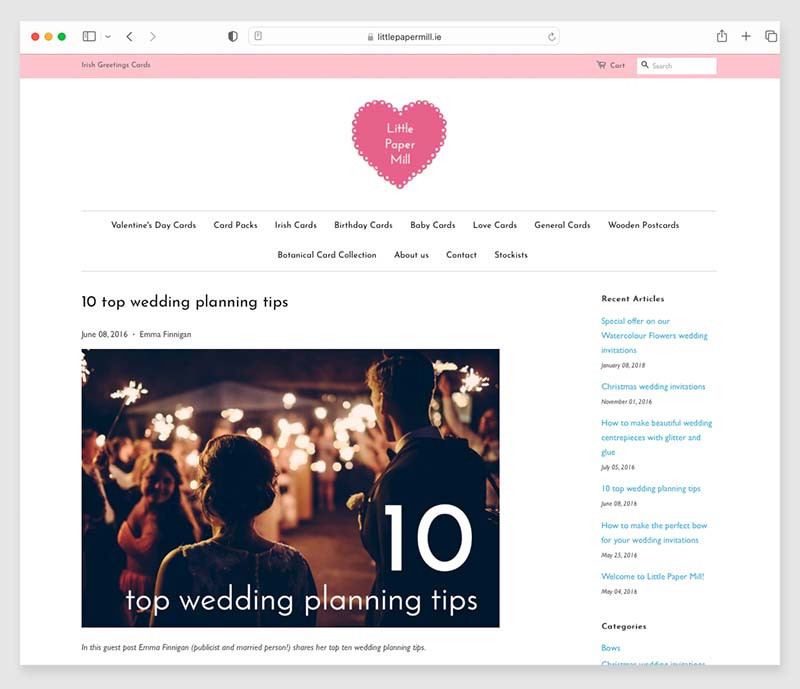
Email marketing
Another key difference point between Shopify and eBay involves email marketing.
When you subscribe to Shopify, you get access to its ‘Shopify Email’ app — a tool that lets you capture email addresses, create branded e-newsletters and program basic autoresponder cycles.
eBay gives you a simple tool for creating newsletters, too — if you run an eBay shop you can send one newsletter every two weeks to your customers.
There are two key differences to note between the email marketing tools provided by both platforms.
The first involves branding: while Shopify gives you full control over the look and feel of your newsletters, eBay restricts you to using its standard templates.
The second involves the exportability of your data. With Shopify, you can export any email addresses you capture — but eBay doesn’t facilitate this. A workaround exists however: if your eBay customers buy from you via PayPal, you can export their details from there (it’s a bit unclear however how this sits with data protection regulation, though).
The bottom line is that email marketing is much more straightforward, and flexible, with Shopify.
Local selling and point of sale

Because of all the lockdowns necessitated by COVID-19, millions of ‘physical’ businesses had to suddenly embrace online selling.
Many of these businesses turned to Shopify at this time, and with good reason — the platform offers a really wide range of ways to sell online, facilitate pickups and provide local delivery services.
The advantages of using Shopify in a local selling context are not confined to operations, however.
Because Shopify lets you build your own website, local businesses can use Shopify to create fully-branded ecommerce stores that really reflect the atmosphere, vibe and ethos of their bricks and mortar stores. This isn’t really the case with eBay, which at the end of the day is more about displaying product listings efficiently.
Additionally, by running a standalone site on your own domain — i.e., a Shopify site that lives at yoursitename.com — you can make the most of local SEO tactics that raise the visibility of your business in your area too.
But most importantly from a local selling point of view, Shopify comes with a sophisticated point-of-sale (POS) system; this works with a wide range of hardware items that lets you take payment in person (card readers, barcode scanners, receipt printers etc.).
To get a sense of how good Shopify POS is, I interviewed my friend Liz Jones, who uses the system to accept payment in her gift shop. You can watch my video below to get her take on its pros and cons.
The key thing to note here is that Shopify POS gives you the option to use the platform to sell not just online, but in physical locations too — retail outlets, market stalls, pop-up shops etc.
Related resources: Shopify POS pricing guide | Shopify POS Pro vs Lite (video) | Shopify POS vs Square POS
Shopify merchants can therefore use one single system to manage all offline and online sales, all while keeping everything in sync, and inventory levels accurate.

As for eBay, other than letting you offer in-person pickup of items, I couldn’t find many examples of it catering particularly well to local audiences. The platform’s strength lies in giving you access to as many customers in as many places as possible, all over the world.
And, although it is possible to integrate some third-party point-of-sale solutions with eBay, the options for doing so are limited; setting up POS will usually involve a reasonable amount of configuration time and the purchase of a syncing tool like Zapier.
So ultimately, when it comes to local selling, Shopify wins.
SEO in eBay vs Shopify
Whether your eBay or Shopify store becomes a success will depend heavily on your search engine optimization (SEO) efforts. And the approach you’ll need to take to SEO differs considerably for each platform.
When you sell on Shopify, the main search engine you’ll need to concentrate on is Google. Currently used for 89.74% of all search queries (source: Statcounter), it’s the search engine that is most likely to surface ‘standalone’ online stores like those built with Shopify.
With eBay, you’ve got to primarily focus on a different search engine — eBay’s own one. This works in a different way to Google’s — it aims to present search results to shoppers who intend to buy, rather than people who are just browsing for things they might buy.

The eBay search engine is called ‘Cassini’ and uses a ‘best match’ formula to show users the most relevant listings. This takes into account several factors, including:
- how well a product listing matches a shopper’s search terms
- the price of the item
- the quality of the product listing (images, unique product identifiers, product description, etc.)
- the listings terms of service (return policy and handling time)
- the seller’s track record.
To get the most out of your Shopify or eBay store, you will need to fully research the best SEO techniques for both. To this end, I’d recommend checking out the Style Factory Shopify SEO guide as a starting point for Shopify, and Printful’s guide to SEO for eBay.
Tip: You’ll also need to do keyword research to find out what sort of search terms you’ll realistically be able to rank for. Apps like Ahrefs and Semrush are great for getting Google search data; for eBay data, I’d take a look at Keywordtool and eBay’s own SEO tool, Terapeak.
However, an important thing to remember about selling online with eBay is that unlike Shopify, it provides you with two SEO opportunities. Not only can you optimize an eBay’s store’s product listings for eBay’s own search engine, but — because your product listings can be crawled by other search engines — you can get them indexed by Google too.
So technically, an eBay store presents you with more SEO opportunities than a Shopify one.
Customer support
When it comes to customer support, there’s not a huge gap between Shopify and eBay.
oth platforms offer live chat support on all their plans. Phone support is available too — but only on their most expensive tiers. In Shopify’s case, that’s the enterprise-level Shopify Plus plan. With eBay, you’ll need to be on the $349.95 per month Anchor plan to unlock phone and email support.
In terms of ‘self-serve’ help, eBay and Shopify both provide very comprehensive help portals containing lots of detailed ‘how-to’ guides and video tutorials.
Shopify’s AI-powered chatbot also deserves a mention. It’s quick, accurate, and often capable of resolving common issues without the need to escalate to a human agent — a genuinely helpful first line of support.
A feature in eBay’s help portal that I particularly liked was its ‘ask an expert seller’ option. This allows you to direct a query to an experienced eBay seller, which can come in very handy if you’re struggling with one of your product listings.

So, when it comes to customer support, it’s a draw.
Pricing
I’ve discussed how Shopify and eBay work, and the key features of each platform — now let’s take a look at how much they cost to sell with.
Shopify fees
Shopify provides five monthly pricing plans:
- Starter — $5 per month
- Basic — $39 per month
- Grow — $105 per month
- Advanced — $399 per month
- Shopify Plus — custom pricing starting at $2,300 depending on requirements.
A free trial is also available, which you can access this via this link.
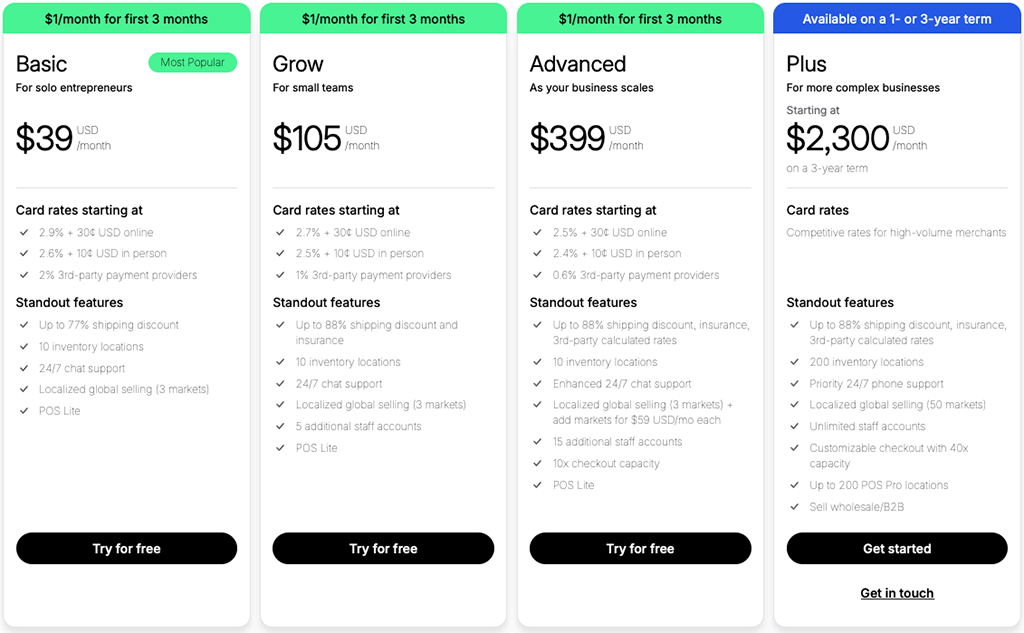
If you pay annually for your Shopify plan, you can avail of a 25% discount — meaning that monthly costs for the ‘Basic,’ ‘Grow’ and ‘Advanced’ plans are reduced to $29, $79 and $299 respectively.
All five Shopify plans give you access to core ecommerce functionality (including unlimited digital and physical product catalogues, the ability to accept credit card payments, gift cards, abandoned cart recovery, discount codes and an SSL certificate) — but there are some several important differences to watch out for between Shopify plans.
These are as follows:
- The Shopify ‘Starter’ plan doesn’t let you build a fully-customizable standalone online store. Rather, it provides you with a very simple online storefront, allows you to sell on social media and messaging apps (Instagram, Facebook, Whatsapp etc.), embed your products on an existing website via its ‘buy button’ feature, or sell in a physical location.
- How many users you can have on your account varies quite a lot by plan. The ‘Starter’ and ‘Basic’ Shopify plans only provides you with 1 staff account; ‘Grow’ lets you use 5; ‘Advanced’ gives you 15.
- Credit card fees are lower on more expensive plans. They range from 2.5% to 2.9% on Shopify’s main plans in the US (note: in other countries, these payment processing fees can be lower).
- Custom reporting features only become available on the $399 ‘Advanced Shopify’ plan or higher.
- There are no transaction fees on any plan if you use Shopify Payments (Shopify’s built in payment gateway). However, if you use a third-party payment processor, transaction fees do apply and these vary depending on the plan you’re on.
- Multicurrency features are better on the ‘Advanced Shopify’ and ‘Shopify Plus’ plans than the cheaper plans.
- The ‘Shopify Plus‘ plan is focused on corporate users, and prices vary depending on your needs. On this plan, you can expect advanced store management features (for up to 10 stores in total); enhanced security; greater access to the Shopify API; dedicated account management; and priority customer support.
eBay costs
Quite a few fee types are involved with selling on eBay:
- Insertion fees — $0.05-$0.35 for every product you list on it.
- Final value fees — a percentage of the final sale price plus $0.30 – $0.40 per order (typically 13.25% — but the percentage varies by product category and plan).
- International sales fees — 1.65% of the total sale amount for US sellers if your customer is based in another country (for non-US sellers, this international fee depends on location).
- Currency conversion fees — a 3% fee calculated from the base exchange rate on the day of purchase.
In terms of what all this means for sellers, there is no getting away from the fact that eBay takes a large cut of each product sold on the platform.
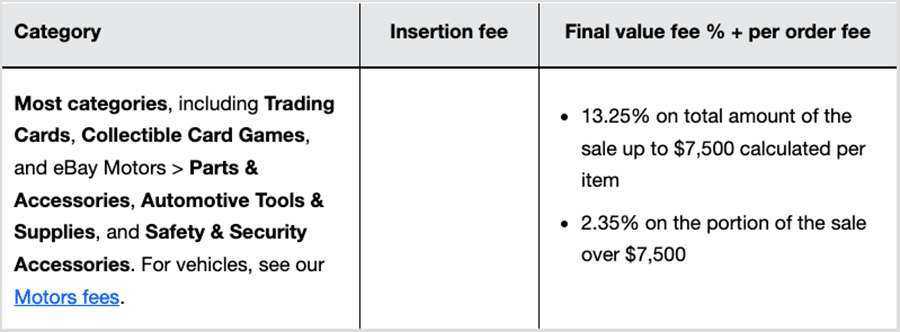
Now, if you’re just selling an occasional item from time to time, eBay allows you to list up to 250 items every month without incurring any insertion fee. These items remain on the platform until you cancel the listing.
However, professional sellers will be better served by subscribing to the platform and creating an ‘eBay store’. By subscribing to a store plan, you’ll avail of cheaper ‘final value’ fees (these are typically 9% – 11% for eBay store owners, but vary by product category); you’ll also get more free listing insertions too.
There are 5 eBay store subscription plans and these are as follows:
- Starter Store — $7.95 per month
- Basic Store — $27.95 per month
- Premium Store — $74.95 per month
- Anchor Store — $349.95 per month
- Enterprise Store — annual pricing only: $2,995.95
Paying on an annual basis for an eBay store subscription brings a sharp reduction in most of these fees, lowering your monthly cost as follows:
- Starter Store — $4.95 per month
- Basic Store — $21.95 per month
- Premium Store — $59.95 per month
- Anchor Store — $299.95 per month
The key differences between the eBay subscriptions plans are:
- The number of free listings per month — these depend on the plan. The ‘Starter’ plan gives you 250 free listings per month; the ‘Basic’ plan gives you 1,000; and the ‘Premium,’ ‘Anchor’ and ‘Enterprise’ plans let you list 10K, 25K and 100K products respectively.
- The cost of adding extra listings over your plan allowance reduces as you go up the eBay store pricing ladder. For example, if you need to go over the 1,000 products allowance on the ‘Basic’ plan, each extra listing will cost you $0.25; while each extra listing on the ‘Premium’ and ‘Anchor’ plans will cost you $0.10 and $0.05 respectively.
- On the ‘Basic’ plan or higher, you receive a quarterly allocation of eBay branded shipping supplies — these range in value from $25 on ‘Basic’ to $150 on the ‘Anchor’ and ‘Enterprise’ plans.
- The two most expensive plans, ‘Anchor’ and ‘Enterprise,’ provide priority customer support by phone and email.
Now, although the Shopify and eBay platforms are quite different in nature, eBay’s approach to fees technically makes it the more expensive platform to sell products on (especially when you factor in the ‘final value’ fees).
That said, many merchants will gladly pay extra to access the ‘ready-made’ audience you get on eBay.
Depending on your ecommerce needs, if you are thinking of using Shopify, then I normally recommend the ‘Shopify’ plan as the ‘sweet spot’ option; and if you want to set up an eBay store, the ‘Basic’ or ‘Premium’ store plans are probably the best starting points for professional merchants.
Finally, if you want to avoid listing fees altogether and sell an unlimited number of products, the better option is Shopify.
Auctions in eBay vs Shopify
When eBay was founded back in 1995, it was set up as a site for running online auctions, and this method of selling products remains a popular option for many eBay store owners today.
The eBay pricing subscriptions mentioned above all include auction listings in addition to fixed price product listings — i.e., you can create up to 250 auctions on the ‘Basic’ plan; and the ‘Premium,’ ‘Anchor’ and ‘Enterprise’ plans let you run 500, 1,000 and 2,500 auctions respectively.
But it is worth mentioning that Shopify can actually cater for auction-style selling too.
There are around 167 auction apps in the Shopify app store, and these allow you to run auctions on your Shopify store, set reserve prices and manage customer bids.
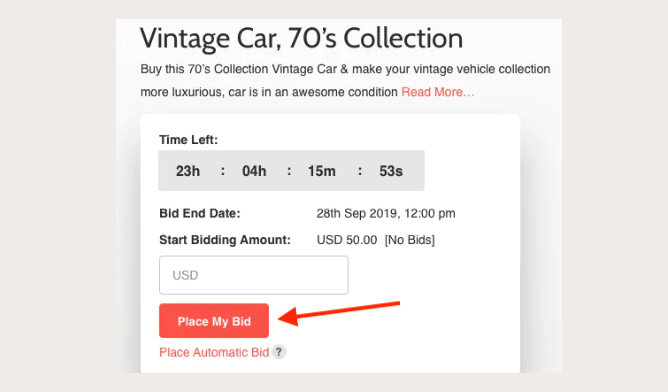
Nonetheless, by virtue of its history as an online auction platform, eBay will usually be the better option for running auctions, and one that users will feel more comfortable using for bidding on products.
Apps and integrations
Most ecommerce platforms allow you make use of third-party software to add extra functionality to your ecommerce site, and eBay and Shopify are no exceptions here. However, Shopify gives you a lot more choice in this department.
To access add-ons for Shopify, you go to its app store — this contains over 16,000 apps, which either let you add new features to your Shopify store, or integrate it with popular third-party tools.
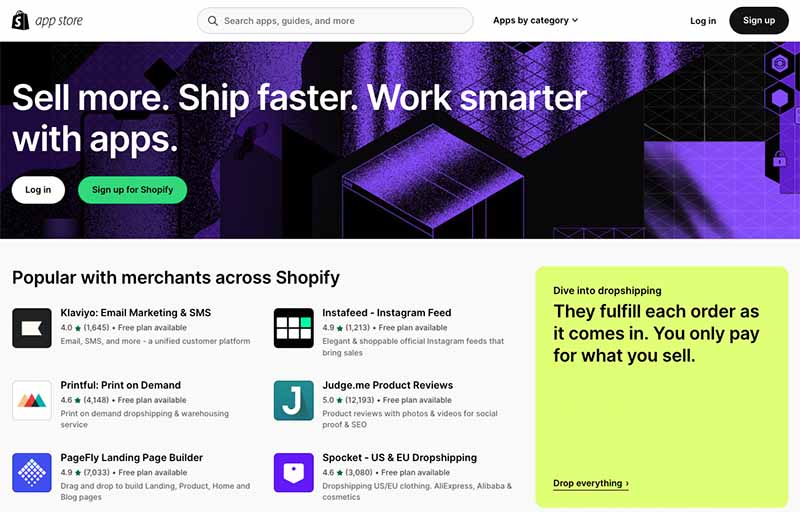
By contrast, eBay does not have an ‘app store’ or centralized directory of extensions (it used to have one but it was closed down in 2018). However, it is still possible to add extra functionality to your eBay store via external software integrations.
There are 60+ third-party integrations available for eBay in total, covering activities such as inventory management, order management, shipping and fulfillment.
This difference in quantity of third-party integrations between Shopify and eBay arguably boils down to the fact that they are quite different selling tools.
There’s less of a need for users to add apps to eBay, because it already includes all the key the functionality sellers need to sell effectively on its marketplace.
By contrast, Shopify is designed to cater for a much wider range of online business types — so there is more of a need to offer tools that facilitate their differing needs.
Using Shopify and eBay together
Although this Shopify vs Etsy comparison has so far focused on the many differences between the two platforms, I must stress that they don’t have to be used in a mutually exclusive way.
There are around 230 apps in the Shopify app store that let you integrate your Shopify and eBay stores.
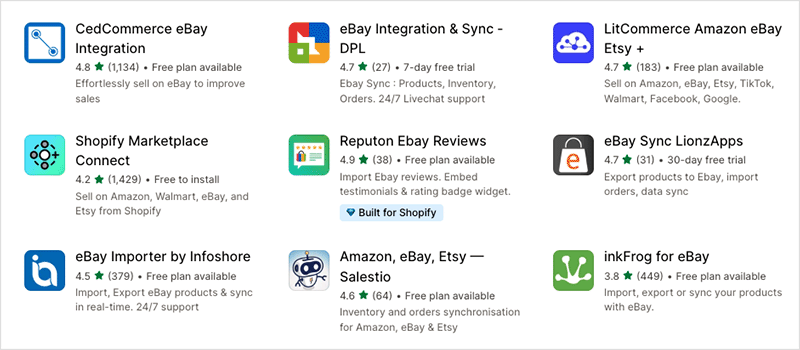
These apps let you:
- create new listings for products on eBay
- sync product inventory, orders and pricing details in real time
- manage eBay business policies.
Of these apps, the ‘Shopify Marketplace Connect’ app (formerly ‘Codisto’) is the most tightly integrated with the Shopify CMS.
Using this, Shopify merchants on the ‘Basic’ and higher plans can sync 50 eBay orders for free to their Shopify stores every month by (with Shopify taking a 1% fee per additional synced-orders; total fees are capped at $99 per month).
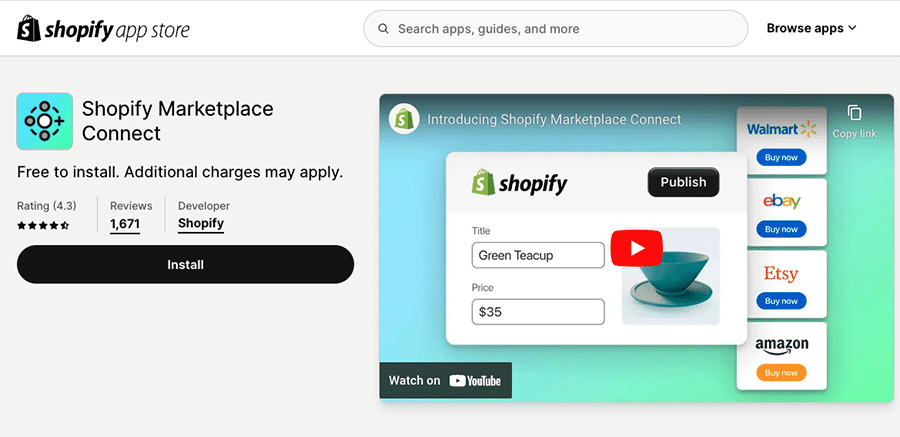
Other third-party apps for connecting eBay and Shopify together typically involve fees varying from $29 to $149 (depending on how many eBay listings you want to manage).
Ultimately, using these apps to connect Shopify and eBay lets you get the best of both worlds — a branded online web store that you control through Shopify, and access to eBay’s huge audience of ‘high-intent’ buyers.
The video below provides an introduction to the popular ‘CedCommerce’ eBay-Shopify integration.
Ultimately, by listing your products on Shopify AND eBay, you’re giving yourself more opportunities to grow your ecommerce business.
Mobile apps and managing Shopify and eBay on the go
Shopify and eBay both provide users with mobile apps for managing their stores on the go. Let’s take a quick look at these.
Shopify mobile apps
Shopify actually offers several different mobile apps, with the most relevant ones for merchants being the ‘Shopify’ app and the ‘Shopify POS’ app.
The ‘Shopify’ app lets you add products, edit your store’s design and view basic stats.
The ‘Shopify POS’ app is a dedicated tool for taking orders and accepting payments for goods in physical locations — it allows you to manage exchanges and returns, accept a range of payment methods and issue receipts to in-person customers.
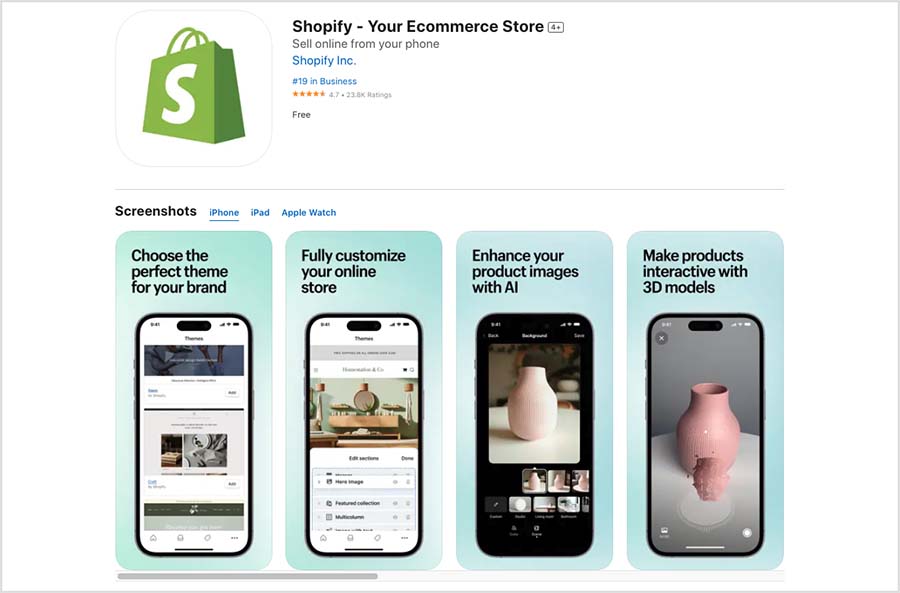
The other Shopify mobile apps on offer include a customer communication app (‘Shopify Inbox’), a shopping app (‘Shop’) and apps for sourcing free images and making logos.
eBay mobile apps
eBay offers two mobile apps: the main ‘eBay Marketplace‘ app, which can be used by both shoppers and merchants to buy and sell on the platform; and a dedicated app for buying and selling vehicles and car parts, ‘eBay Motors.’
One of the most useful features of the main eBay app for merchants is that, thanks to an integrated barcode scanner, it takes some of the pain out of the process involved with listing your products.
When you scan a product’s barcode, all of the product details are automatically added to your eBay listing. This means you don’t have to manually enter every single product detail for every single listing (a huge time saver).
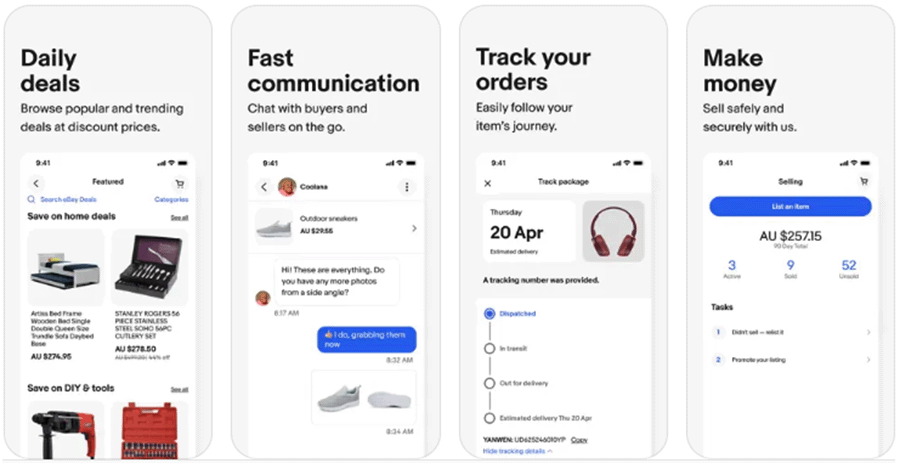
eBay’s app also includes some handy image editing functionality too, including a background removal tool.
In terms of reviews of the main Shopify and eBay apps, they both score well with users: the main Shopify app is rated 4.7 out of 5 by iOS users and 4.3 by Android users; the eBay app is rated 4.8 out of 5 by by iOS users, and 4.7 out of 5 by Android ones.
Shopify vs eBay conclusion
When I compare two different ecommerce platforms, I usually try to declare an overall ‘winner.’ However, because Shopify and eBay work in quite different ways, in this case it is probably more useful for me to highlight the contexts where it makes more sense for you to use one over the other.
So, below you’ll find a summary of my main reasons for using Shopify or eBay — do leave a comment if you have any queries or feedback of your own to share.
eBay vs Shopify — pros and cons summary
Reasons I’d use eBay over Shopify
- eBay places your products in front of a very large existing audience — but with Shopify, you’ll need to grow your own traffic and customer base.
- You can avoid monthly fees with eBay, so long as you’re selling less than 250 items. (However, eBay’s ‘final value fees’ will still be applied to any products you sell).
- There’s no web design work to worry about with eBay — you are simply listing products on an existing marketplace.
- It’s a much better tool than Shopify for running online auctions.
- eBay’s algorithmic features (for example, its ‘recommend items’ section and ‘great price’ badges) can generate a lot of traffic to your listings with little effort from you.
- eBay sellers can target two search audiences — those using eBay’s own ‘Cassini’ search engine, and those using traditional search engines (like Google).
👉 You can learn more about selling on eBay here.
Reasons I’d use Shopify over eBay
- Shopify is the better option for merchants who need a standalone site on a domain of their choosing.
- It’s a much more customizable platform, and gives you much more control over how your brand is represented than eBay.
- Thanks to its comprehensive point of sale features, Shopify is a better option for businesses that engage in local selling in markets, events and pop-up shops.
- Shopify lets you perform content marketing out of the box via its blogging features.
- Its email marketing tools are considerably more sophisticated than eBay’s (and let you export your customers’ email addresses too).
- Shopify’s app store gives you access to a huge number of interesting ecommerce tools and integrations, most of which aren’t available for eBay.
- eBay takes a large chunk of each sale in fees (even eBay store subscribers, who pay on a monthly basis, face hefty transaction fees on top of their subscription costs). Shopify’s equivalent fees are considerably lower (and can be avoided entirely if you use its ‘Shopify Payments’ service).
- You can sell a Shopify store to somebody else; this is not the case with an eBay one.
While you’re here, download our free ecommerce e-kit
For a limited time, we’re offering our readers some excellent free tools. Sign up free to immediately receive:
- our online store comparison chart
- a downloadable cheatsheet on how to create an online store
- our SEO, blogging and ‘how to start a business’ cheatsheets
- extended free trials and discount codes for essential business apps
- our latest tips on ecommerce and growing a business
Alternatives to Shopify and eBay
When it comes to alternative options to Shopify, we generally recommend BigCommerce as the most obvious competing hosted store builder; it’s similarly priced and broadly speaking gives you the same ecommerce features as Shopify (its main advantage over Shopify is that many of these are available ‘out of the box’ rather than as apps).
You can learn more about BigCommerce in our BigCommerce vs Shopify comparison or our full BigCommerce review.
Squarespace is definitely also worth considering — although its ecommerce features are more basic than Shopify’s, its interface is great, its templates are extremely good and its content marketing features are strong.
You can check out our Shopify vs Squarespace comparison here, our guide to the Squarespace free trial here and our full Squarespace review here.
If you’re on a budget, you could consider Wix — this product is available at a slightly lower price point than Shopify and Squarespace, while boasting a reasonably good set of ecommerce features. Check out our Wix review or read our detailed Shopify vs Wix comparison for more information.
Other budget-friendly hosted ecommerce solutions include Godaddy and Big Cartel. Check out our Godaddy vs Shopify and Big Cartel vs Shopify comparisons to see how these platforms compare with Shopify.
As for alternatives to eBay, the obvious alternative is Amazon — our Shopify vs Amazon comparison discusses how it stacks up against Shopify.
If you’re a business owner that sells vintage or handmade items, the Etsy online marketplace is well worth investigating — you can read about its core features in our Shopify versus Etsy comparison.
Finally, it’s worth taking a look at Ecwid. This app is primarily designed to allow you add an online store to an existing website or online presence, but it also comes with some very good tools for getting your products onto big online marketplaces, including Google Shopping, Walmart, Amazon and eBay.
You can read more about this product in our full Ecwid review.
Related Style Factory content
Shopify vs eBay in numbers
| Shopify | eBay | |
| Year founded | 2006 | 1995 |
| Number of merchants | 4.9 million | 19 million |
| Number of buyers | 57 million per month (Source: Influencer Marketing Hub.) | 132 million per month (Source: eBay.) |
| Free plan | No | Yes, if you sell less than 250 items per month |
| Subscription pricing | $5 — $399 | $4.95 — $349.95 |
| Enterprise pricing | Starts at $2,300 per month | Starts at $2,995.95 per month |
| Templates | 246 | None |
| Blogging features | Yes | No |
| Apps | 16,000+ | 60+ |
| iOS app rating | 4.7 stars | 4.8 stars |
| Android app rating | 4.3 stars | 4.7 stars |
| Free trial | Yes — details here | No |
No comments